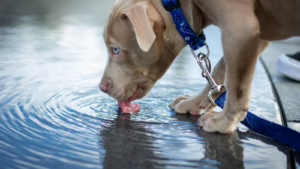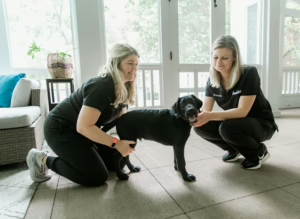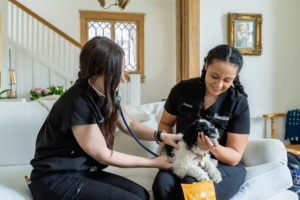Pets typically require a dental cleaning when they start showing signs of dental disease. According to the American Veterinary Dental Society, about 80% of dogs and 70% of cats have some form of dental disease by the age of 3 — a disease that will worsen if left untreated.
Dental disease can progress quickly and cause a lot of pain and discomfort for your pet, so cleanings are an important part of pet dental health and preventative care. Your veterinarian can assess if your pet needs a dental cleaning and recommend the appropriate timing for a dental cleaning based on your pet’s individual needs.
In general, most dogs and cats require dental cleanings every 1-2 years, but this can vary depending on factors such as age, breed, diet, and overall dental health.
There are several signs that may indicate that your pet needs a dental cleaning:
- Bad breath: Persistent bad breath is often a sign of dental disease in pets.
- Yellow or brown teeth: If your pet’s teeth have visible discoloration, this could be a sign of tartar buildup.
- Difficulty eating: If your pet is having difficulty eating or is dropping food, this could indicate dental pain.
- Swollen or bleeding gums: Inflamed or bleeding gums can be a sign of gingivitis or periodontal disease.
- Changes in behavior: If your pet is suddenly avoiding their food or toys, this could indicate dental pain.
If you notice any of the signs above, it’s important to schedule an exam with your veterinarian.
What’s a COHAT?
COHAT is short for Complete Oral Health Assessment and Treatment, also known as a pet dental cleaning. Pets need to receive similar dental care to people, including:
- A comprehensive oral exam to address abnormalities in the teeth, gums, tongue, or other tissues.
- Radiographs (X-rays) to evaluate the health of the jawbone and tooth roots below the gum line.
- Dental cleaning and polishing under anesthesia to remove plaque and tartar.
What happens during a COHAT?
Dental cleanings involve removing tartar and plaque buildup from a pet’s teeth and gums to improve oral hygiene and prevent dental disease. The cleaning process typically involves the following steps:
- Examination: Your pet’s veterinarian will examine their mouth to evaluate the extent of dental disease and identify any potential problems.
- Anesthesia: To ensure the pet remains still and comfortable during the cleaning, and for the safety of the veterinary staff, dental cleanings are performed under general anesthesia.
- Scaling: Using a special tool, the veterinarian will carefully scrape away any tartar and plaque buildup on the teeth and gums. This is important to remove the buildup that can cause bad breath and gum disease.
- Polishing: Once the teeth are scaled, they are polished to smooth out any rough spots that could promote plaque buildup.
- Post-cleaning examination: After the procedure, the veterinarian will examine the pet’s mouth again to ensure that everything looks healthy and that the pet is recovering properly from the anesthesia.
How much is a pet dental cleaning?
Being one of the more expensive routine procedures, many pet parents refrain from dental care due to sticker shock. However, neglecting your pet’s dental health can give rise to severe consequences, such as constant pain, infections, abscesses, and even organ damage. Addressing these issues later may incur greater expenses than opting for regular dental cleanings.
Our dental cleaning services are typically priced between $500 and $700. This does increase if any dental extractions are needed. A COHAT is a truly comprehensive evaluation and treatment of your pet’s oral health, ultimately improving their quality and length of life.




